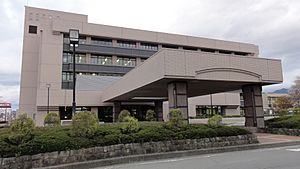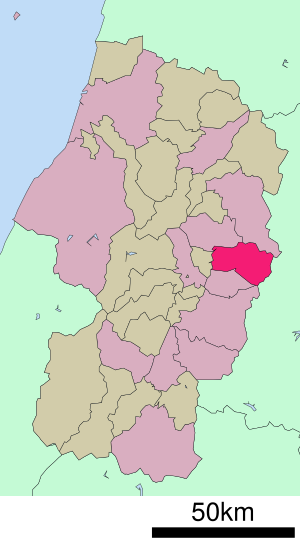Higashine facts for kids
Quick facts for kids
Higashine
東根市
|
|||||||||||
|---|---|---|---|---|---|---|---|---|---|---|---|

Higashine City Hall
|
|||||||||||
|
|||||||||||

Location of Higashine in Yamagata Prefecture
|
|||||||||||
| Country | Japan | ||||||||||
| Region | Tōhoku | ||||||||||
| Prefecture | Yamagata | ||||||||||
| Area | |||||||||||
| • Total | 207.17 km2 (79.99 sq mi) | ||||||||||
| Population
(February 2020)
|
|||||||||||
| • Total | 47,910 | ||||||||||
| • Density | 231.259/km2 (598.96/sq mi) | ||||||||||
| Time zone | UTC+9 (Japan Standard Time) | ||||||||||
| Phone number | 0237-42-1111 | ||||||||||
| Address | 1-1-1 Chūō, Higashine-shi, Yamagata-ken 999-3795 | ||||||||||
| Climate | Cfa/Dfa | ||||||||||
|
|||||||||||
Higashine (東根市, Higashine-shi) is a city located in Yamagata Prefecture, Japan. As of February 2020, about 47,910 people lived there. The city covers an area of 207.17 square kilometers.
Contents
Geography and Location
Higashine is found on the eastern side of the Mogami River. It sits in the northern part of the Yamagata Basin. The city's main area is on a flat landform called an alluvial fan. This fan was created by rivers like the Shirasui, Murayamano, and Nitto. These rivers flow from the Ōu Mountains to the east. The western part of Higashine has hills that rise towards these mountains.
Nearby Cities and Towns
Higashine shares borders with several other places:
Climate in Higashine
Higashine has a climate with big changes between seasons. Summers are warm to hot and often humid. Winters are cold, sometimes very cold. It rains a lot throughout the year. The heaviest rain usually falls from August to October.
The average yearly temperature in Higashine is about 11.4 degrees Celsius. The average yearly rainfall is 1088.2 millimeters. July is usually the wettest month. Temperatures are highest in August, around 24.7 degrees Celsius. They are lowest in January, around -1.1 degrees Celsius.
| Climate data for Higashine (2003−2020 normals, extremes 2003−present) | |||||||||||||
|---|---|---|---|---|---|---|---|---|---|---|---|---|---|
| Month | Jan | Feb | Mar | Apr | May | Jun | Jul | Aug | Sep | Oct | Nov | Dec | Year |
| Record high °C (°F) | 12.4 (54.3) |
13.6 (56.5) |
22.3 (72.1) |
29.1 (84.4) |
33.5 (92.3) |
37.0 (98.6) |
37.0 (98.6) |
36.8 (98.2) |
36.7 (98.1) |
30.3 (86.5) |
23.7 (74.7) |
18.0 (64.4) |
37.0 (98.6) |
| Mean daily maximum °C (°F) | 2.3 (36.1) |
3.5 (38.3) |
8.3 (46.9) |
15.7 (60.3) |
22.3 (72.1) |
26.0 (78.8) |
28.4 (83.1) |
30.2 (86.4) |
26.0 (78.8) |
19.3 (66.7) |
12.3 (54.1) |
5.4 (41.7) |
16.6 (61.9) |
| Daily mean °C (°F) | −1.1 (30.0) |
−0.5 (31.1) |
3.1 (37.6) |
9.0 (48.2) |
15.5 (59.9) |
20.0 (68.0) |
23.3 (73.9) |
24.7 (76.5) |
20.5 (68.9) |
13.4 (56.1) |
7.0 (44.6) |
1.6 (34.9) |
11.4 (52.5) |
| Mean daily minimum °C (°F) | −5.3 (22.5) |
−5.0 (23.0) |
−2.1 (28.2) |
2.5 (36.5) |
8.7 (47.7) |
14.4 (57.9) |
19.2 (66.6) |
20.2 (68.4) |
15.7 (60.3) |
7.9 (46.2) |
2.1 (35.8) |
−2.3 (27.9) |
6.3 (43.4) |
| Record low °C (°F) | −15.0 (5.0) |
−14.2 (6.4) |
−10.7 (12.7) |
−5.7 (21.7) |
−0.2 (31.6) |
4.9 (40.8) |
10.1 (50.2) |
11.5 (52.7) |
4.9 (40.8) |
−0.7 (30.7) |
−5.8 (21.6) |
−12.2 (10.0) |
−15.0 (5.0) |
| Average precipitation mm (inches) | 90.4 (3.56) |
53.1 (2.09) |
61.6 (2.43) |
59.7 (2.35) |
63.4 (2.50) |
86.1 (3.39) |
162.3 (6.39) |
123.1 (4.85) |
100.3 (3.95) |
96.0 (3.78) |
80.8 (3.18) |
111.3 (4.38) |
1,088.2 (42.84) |
| Average precipitation days (≥ 1.0 mm) | 16.6 | 12.8 | 12.2 | 9.7 | 8.5 | 8.5 | 13.2 | 10.4 | 9.7 | 10.5 | 13.7 | 17.3 | 143.1 |
| Source: Japan Meteorological Agency | |||||||||||||
Population Growth
The number of people living in Higashine has grown steadily. This has happened over the last 50 years.
| Historical population | ||
|---|---|---|
| Year | Pop. | ±% |
| 1920 | 25,059 | — |
| 1930 | 28,626 | +14.2% |
| 1940 | 30,257 | +5.7% |
| 1950 | 42,767 | +41.3% |
| 1960 | 40,917 | −4.3% |
| 1970 | 39,113 | −4.4% |
| 1980 | 40,559 | +3.7% |
| 1990 | 42,751 | +5.4% |
| 2000 | 44,800 | +4.8% |
| 2010 | 46,414 | +3.6% |
| 2020 | 47,682 | +2.7% |
History of Higashine
The area where Higashine is today has a long history. It was part of an old province called Dewa Province. Records from the early Heian period mention this area. During the Edo period, much of the land was controlled by the Matsumae Domain.
After the Meiji period began, Higashine became part of Yamagata Prefecture. The village of Higashine was officially created on April 1, 1889. It became a town on June 15, 1896. Finally, it became a city on November 3, 1958.
Economy and Local Products
Higashine is often called "The Fruit Kingdom." It is very famous for its cherries. The city also grows many apples, pears, and persimmons. Higashine is the biggest producer of cherries in Yamagata Prefecture. Yamagata is the third largest cherry producer in all of Japan.
The city even has a special mascot! It looks like a pear with cherry earrings and holds a staff with an apple on top.
Higashine also has a large area for industries and businesses. Some well-known companies here include 3M, Casio, THK, ODELIC, and Kyocera. Many of these companies focus on making things and developing new ideas.
Education in Higashine
Higashine has many schools for young people. The city government runs nine public elementary schools. It also operates five public middle schools. For older students, there is one public high school. This high school is managed by the Yamagata Prefectural Board of Education. There is also a special education school for students with disabilities.
Transportation Options
Higashine has different ways to travel in and out of the city.
Air Travel
- Yamagata Airport is located here.
Train Services
![]() East Japan Railway Company - Yamagata Shinkansen
East Japan Railway Company - Yamagata Shinkansen
- Sakuranbo Higashine
![]() East Japan Railway Company - Ōu Main Line
East Japan Railway Company - Ōu Main Line
- Jinmachi - Sakuranbo Higashine - Higashine
Major Highways
 Tōhoku-Chūō Expressway – Higashine Interchange
Tōhoku-Chūō Expressway – Higashine Interchange National Route 13
National Route 13 National Route 48
National Route 48 National Route 287
National Route 287
Notable People from Higashine
Many interesting people come from Higashine. Here are a few:
- Kazushige Abe, a novelist who won the Akutagawa Prize.
- Masatoshi Abe, a politician.
- Tomoaki Honma, a professional wrestler.
See also
 In Spanish: Higashine (Yamagata) para niños
In Spanish: Higashine (Yamagata) para niños




